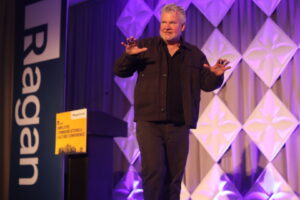Why virtual meetings and conferences will continue to thrive
Even as the pandemic abates, companies should still plan to invest in videoconferencing tech and tools. Here’s why.

MeetingPlay is a company that facilitates connections between meeting attendees and conference operators — driving interest before an event, maintaining connections during it and providing a continuing relationship afterward. Then why does Joe Schwinger, CEO, say that his go-to contact at clients has shifted from the meeting planner to the CMO?
The event industry, explained Schwinger, has experienced “an Uber moment” – meaning a fundamental shift. Just as there was a time when it was unimaginable to jump into a stranger’s car as is the case with Uber, it is now a time that companies are forced to reimagine meetings. When a deal needs to be done, said Schwinger, that will always involve a face-to-face session. Otherwise, virtual or hybrid conferences are the story for the future.
Deal-making aside, now is the time to focus on the marketing aspect and power being put into these virtual and hybrid events because of the sheer potential size of the audience. Large-scale meeting attendance has multiplied tenfold in some cases — with many “attendees” signing up just days in advance. Without having capacity limitations, ballroom size or any other constraints, attendance can leap from 10,000 to 30,000 four days before the opening speech.
Schwinger said that he can now walk into a CMO’s office and say, “I will be able to take your demos, product announcements and other content — and instead of putting it in front of 5,000 people who represent high acquisition costs, we can put it in front of many more people virtually at $50-$70 per attendee.”
While it’s true that people who take the time and expense to fly to an event might have greater motivation, the sheer volume of virtual participation easily overrides that. On top of that, Schwinger has seen a 15% increase in new attendee counts after events have ended.
Measurement is also key here. Schwinger explained that in a face-to-face environment there will always be gaps in data about how an attendee behaved on property. The beauty of a virtual platform is complete and comprehensive data on attendee behavior.
As an example, Schwinger pointed to a New York Post virtual writers conference where the newspaper marketed to writers based on their individual interests. There were 200 sessions, and from the moment someone logged in, all of his or her actions produced a wealth of data: verifying sessions watched, whether they spent only five minutes at a session and saw others in their entirety, etc.
If it’s a technology customer rolling out a product, said Schwinger, the conference operator can easily learn that a customer has a small interest in apps, but a big interest in search engines. “What does that provide to the marketing team?” asked Schwinger. CMOs “want data, reach and an always-on solution.”
Looking ahead, in-person meetings, or even a significant number of hybrid meetings, seem to be further away in time than more recently anticipated. He believes there will be small gatherings, maybe 500 people, of dealmakers and those representing the customers bringing the highest ROI.
To deal with the ongoing pandemic, MeetingPlay has enhanced some benefits and added others. For instance, it created an ambassadors program where on-site attendees are trained to generate excitement for those participating virtually.
Schwinger also pointed to virtual phenomena like Twitch, where millions might watch others play video games, or even play chess. It is now an acceptable environment, he said, for viewers to watch and engage through the eyes of others.
It does seem clear that the ability to “reach” large numbers of people at relatively low cost will reshape conferences. There may be a rush back to face-to-face meetings when the pandemic is over, but lessons learned during this period will ensure that virtual elements will be far more important than ever.
It’s easy to complain about being “Zoomed out,” but Zoom and its kin are here to stay, and will grow in importance as a marketing tool, for meetings and beyond.
Harvey Chipkin is a freelance and travel writer. Read more of his work on MediaPost.






